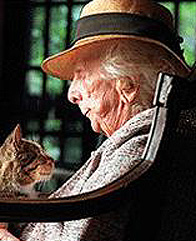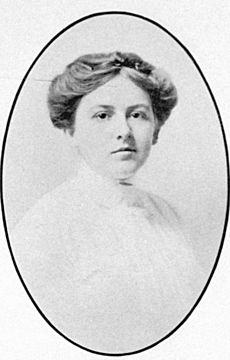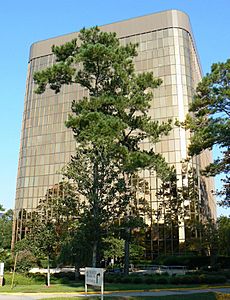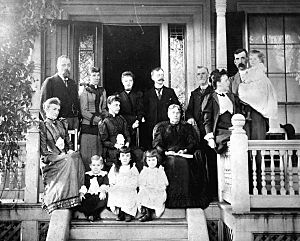Marjory Stoneman Douglas facts for kids
Quick facts for kids
Marjory Stoneman Douglas
|
|
|---|---|
 |
|
| Born |
Marjory Stoneman
April 7, 1890 Minneapolis, Minnesota, U.S.
|
| Died | May 14, 1998 (aged 108) |
| Occupation |
|
| Known for | Everglades conservation advocacy |
| Spouse(s) |
Kenneth Douglas
(m. 1914; div. 1915) |
Marjory Stoneman Douglas (born April 7, 1890 – died May 14, 1998) was an American journalist, author, and environmental activist. She is famous for protecting the Everglades in Florida. She fought against plans to drain this special wetland for building projects.
Marjory moved to Miami when she was young and worked for The Miami Herald. She became a freelance writer, creating over 100 short stories for popular magazines. Her most important book was The Everglades: River of Grass (1947). This book changed how people saw the Everglades, from a useless swamp to a valuable "river of grass." Its impact was so big that it's often compared to Rachel Carson's famous book Silent Spring.
Marjory was also a strong supporter of women's suffrage, which means women's right to vote. When she was 79, she took on a major role in protecting the Everglades. For the next 29 years, she was a "fearless crusader" for nature in South Florida. People called her the "Grande Dame of the Everglades." She received many awards, including the Presidential Medal of Freedom.
Marjory lived to be 108 years old, working almost until the very end of her life. An obituary in The Independent newspaper said she was one of the most remarkable figures in the American environmental movement.
Contents
Early Life and Education
Marjory Stoneman was born on April 7, 1890, in Minneapolis, Minnesota. She was the only child of Florence Lillian Trefethen and Frank Bryant Stoneman. One of her earliest memories was crying when her father read The Song of Hiawatha. She was a very early and eager reader. Her first book was Alice's Adventures in Wonderland.
When she was four, Marjory visited Florida. She remembered picking an orange from a tree at the Tampa Bay Hotel. Her parents separated when she was six. Marjory found comfort in reading and soon started writing. At 16, she contributed a puzzle to St. Nicholas Magazine, a popular children's publication. In 1907, she won a prize from the Boston Herald for a story called "An Early Morning Paddle."
College and a Brief Marriage

Marjory went to Wellesley College in 1908. She was an excellent student, graduating with a degree in English in 1912. She joined the first women's suffrage club at her college. After graduation, her mother died from cancer.
In 1914, Marjory met Kenneth Douglas and married him quickly. He claimed to be a newspaper editor. However, the marriage ended soon after it became clear he was not who he said he was. Marjory's uncle convinced her to move to Miami and end the marriage. In 1915, Marjory left New England to live with her father in Florida. Her father had remarried Lillius ("Lilla") Eleanor Shine, who Marjory called her "first and best friend" in Florida.
Marjory's Writing Journey
Working at The Miami Herald
Marjory arrived in South Florida when Miami was a small town with fewer than 5,000 people. Her father, Frank Stoneman, was the first publisher of The Miami Herald. He strongly disagreed with Florida's governor, Napoleon Bonaparte Broward, who wanted to drain the Everglades.
Marjory joined the newspaper in 1915. She started as a society columnist, writing about social events. She even admitted to making up some stories when news was slow! Less than a year later, her father left her in charge of the editorial page. She learned to check her facts carefully.
In 1916, Marjory joined the American Red Cross and was sent to Paris during World War I. She saw the celebrations when the war ended and helped people who had lost their homes. This experience helped her understand refugees later in life. After the war, she became assistant editor at The Miami Herald. Her daily column, "The Galley," made her a local celebrity. She wrote about important topics like good city planning, women's right to vote, and civil rights.
One of her most important achievements as a writer happened in the early 1920s. She wrote a poem called "Martin Tabert of North Dakota is Walking Florida Now." It was about a young man who died in a labor camp. This poem was read in the Florida Legislature. It helped pass a law that stopped convict leasing, a system where prisoners were forced to work for private businesses. Marjory said this was the most important thing she ever wrote.
Becoming a Freelance Writer
Marjory left the newspaper in 1923 to become a freelance writer. Between 1920 and 1990, she published 109 fiction stories and articles. Many of her stories appeared in The Saturday Evening Post. Her stories often featured independent women or young underdogs facing unfair situations. The Everglades' animals and people were subjects for some of her early writings. Her story "Wings" (1931) was about the killing of Everglades birds for their feathers.
In the 1930s, she wrote a pamphlet to support a botanical garden. This led her to give speeches and serve on the board for the Fairchild Tropical Botanic Garden. She called it "one of the greatest achievements for the entire area." Marjory also wrote plays. One play, "The Gallows Gate," won a state competition and later a national award.
She was the book review editor for The Miami Herald from 1942 to 1949. She also edited for the University of Miami Press. Her first novel, Road to the Sun, came out in 1952. She wrote several non-fiction books about Florida, including one about birdwatching. Her autobiography, Marjory Stoneman Douglas: Voice of the River, was published in 1987.
The Everglades: River of Grass
In the early 1940s, a publisher asked Marjory to write about the Miami River. She wasn't impressed with it, calling it "an inch long." But while researching, she became fascinated by the Everglades. She convinced the publisher to let her write about the Everglades instead. She spent five years researching its ecology and history.
Marjory worked with geologist Garald Parker. He discovered that the Biscayne Aquifer, South Florida's only source of fresh water, was filled by the Everglades. Marjory asked Parker if she could call the fresh water flowing from Lake Okeechobee a "river of grass." He agreed, and that became the famous nickname for the Everglades.
The Everglades: River of Grass was published in 1947 and quickly sold out. The book's first line, "There are no other Everglades in the world," is very famous. Marjory described the Everglades as a valuable ecosystem, a river that needed protection, and deeply connected to the people of South Florida.
This book inspired many people to protect the Everglades. Its impact is still felt today, as it's a major reason why Florida attracts so many tourists. It has sold over 500,000 copies and is considered a classic of environmental literature.
Marjory's Activism
Marjory was interested in women's right to vote from an early age. In 1917, she traveled to Tallahassee to speak in favor of women's suffrage. She wasn't happy with how the Florida Legislature listened to them. She said, "Talking to them was like talking to graven images. They never paid attention to us at all." Marjory was finally able to vote in 1920.
In 1948, Marjory worked on the Coconut Grove Slum Clearance Committee. She helped pass a law requiring all homes in Miami to have toilets and bathtubs. She also helped set up interest-free loans for black residents in Coconut Grove to pay for plumbing work. All the money loaned was repaid.
Protecting the Everglades
Marjory became involved with the Everglades in the 1920s, joining a group that wanted to make it a national park. By the 1960s, the Everglades were in great danger due to poor management and development. In 1969, at 79 years old, Marjory founded Friends of the Everglades. She started this group to stop the building of a large airport in the Everglades. She explained her involvement by saying, "It is a woman's business to be interested in the environment. It's an extended form of housekeeping."
She traveled around Florida, giving many speeches against the airport project. Her efforts, along with other groups, led President Richard Nixon to stop funding the project.
Marjory continued her activism, focusing on restoring the Everglades. She said, "Conservation is now a dead word... You can't conserve what you haven't got." She criticized "Big Sugar," a group of sugarcane growers, for polluting Lake Okeechobee. She also spoke out against the United States Army Corps of Engineers. The Corps had built many canals to move water away from the Everglades. Marjory said they were "playing with cement" and harming the natural flow of water.
At one hearing in 1983, Marjory faced a crowd of angry residents who booed her. They wanted the Everglades drained so they could build houses. Marjory calmly told them, "Can't you boo any louder than that?" She eventually made them laugh. She said, "They're all good souls—they just shouldn't be out there." The county commissioners eventually decided not to drain the area.
Florida Governor Lawton Chiles said Marjory "was the first voice to really wake a lot of us up to what we were doing to our quality of life. She was not just a pioneer of the environmental movement, she was a prophet."
Other Important Causes
Marjory was a founding member of the first American Civil Liberties Union chapter in the South in the 1950s. She also supported the Equal Rights Amendment. In the 1980s, she helped Florida Rural Legal Services, a group that protected migrant farm workers in Florida.
She also pushed the Dade County School Board to build a proper center for the Biscayne Nature Center. In 1991, the Florida Department of Education gave $1.8 million for the Marjory Stoneman Douglas Biscayne Nature Center. Marjory also helped start the Friends of the Miami-Dade Public Libraries.
Marjory's Personal Life
Marjory described herself as agnostic throughout her life. She did not want any religious ceremony at her memorial. However, she was inspired by her Quaker grandparents, who worked to end slavery. She was proud that Levi Coffin, an organizer of the Underground Railroad, was her great-great-uncle.
Marjory admitted she didn't spend much time in the Everglades itself. She wrote, "To be a friend of the Everglades is not necessarily to spend time wandering around out there... It's too buggy, too wet, too generally inhospitable." She understood that a healthy environment meant a healthy future for people.
Despite her small size (5 feet 2 inches, 100 pounds) and elegant appearance, Marjory was known for her sharp wit and clear way of speaking. She was respected for her dedication and knowledge. A reporter named Jeff Klinkenberg said she "had a tongue like a switchblade and the moral authority to embarrass bureaucrats and politicians and make things happen." She would often dismiss reporters who hadn't read her books.
Marjory never learned to drive or owned a car. Her house also didn't have air conditioning, an electric stove, or a dishwasher.
Awards, Death, and Legacy

Marjory Stoneman Douglas received many honors throughout her life. In 1980, the Florida Department of Environmental Protection named its headquarters in Tallahassee after her. She said she would have preferred to see the Everglades restored than her name on a building.
In 1986, the National Parks Conservation Association created the Marjory Stoneman Douglas Award. This award honors people who fight to protect the National Park System. Even when she was blind and had trouble hearing, Marjory remained active. In 1991, Queen Elizabeth II visited her, and Marjory gave her a signed copy of The Everglades: River of Grass. For her birthdays, Marjory asked for trees to be planted instead of gifts. Over 100,000 trees were planted across Florida because of her wish.
In 1993, when she was 103, President Bill Clinton gave Marjory the Presidential Medal of Freedom. This is the highest award a civilian can receive in the United States. She donated her medal to Wellesley College.
After her death, Marjory was inducted into the National Wildlife Federation Hall of Fame in 1999 and the National Women's Hall of Fame in 2000. She questioned why there was a Women's Hall of Fame and not just a "Citizens' Hall of Fame."
Marjory Stoneman Douglas died at 108 years old on May 14, 1998. Her autobiography co-writer, John Rothchild, said her death was the only thing that could "shut her up." Carl Hiaasen, a famous writer, praised her passion and determination. The National Wildlife Federation called her "a passionate, articulate, and tireless voice for the environment."
Her ashes were scattered in the Marjory Stoneman Douglas Wilderness Area in Everglades National Park. This area was named for her in 1997. Two public schools in South Florida are named in her honor: Marjory Stoneman Douglas High School and Marjory Stoneman Douglas Elementary School.
Marjory's Historic Home
Marjory's cottage in Coconut Grove was built in 1924. She wrote all her major books and stories there. The City of Miami made it an historic site in 1995. After her death, there were ideas to turn the house into an education center.
The State of Florida now owns Marjory's house. In 2007, the Florida Park Service took care of it and began restoring it. A park ranger lives in the house to help maintain it. On Earth Day in 2015, President Barack Obama announced that the house was named a National Historic Landmark.
Notable Works
Books
- The Everglades: River of Grass. 1947.
- Road to the Sun. 1952.
- Freedom River Florida 1845. 1953.
- Hurricane. 1958.
- Alligator crossing. 1959.
- The Key to Paris. 1961.
- Florida the Long Frontier. 1967.
- The Joys of Bird Watching in Florida. 1969.
- Adventures in a Green World – The Story of David Fairchild and Barbour Lathrop. 1973.
- Marjory Stoneman Douglas: Voice of the River. with John Rothchild. 1987.
Short Story Collections
- Nine Florida Stories by Marjory Stoneman Douglas. 1990.
- A River in Flood and Other Florida Stories by Marjory Stoneman Douglas. 1998.
Images for kids
See also
 In Spanish: Marjory Stoneman Douglas para niños
In Spanish: Marjory Stoneman Douglas para niños



